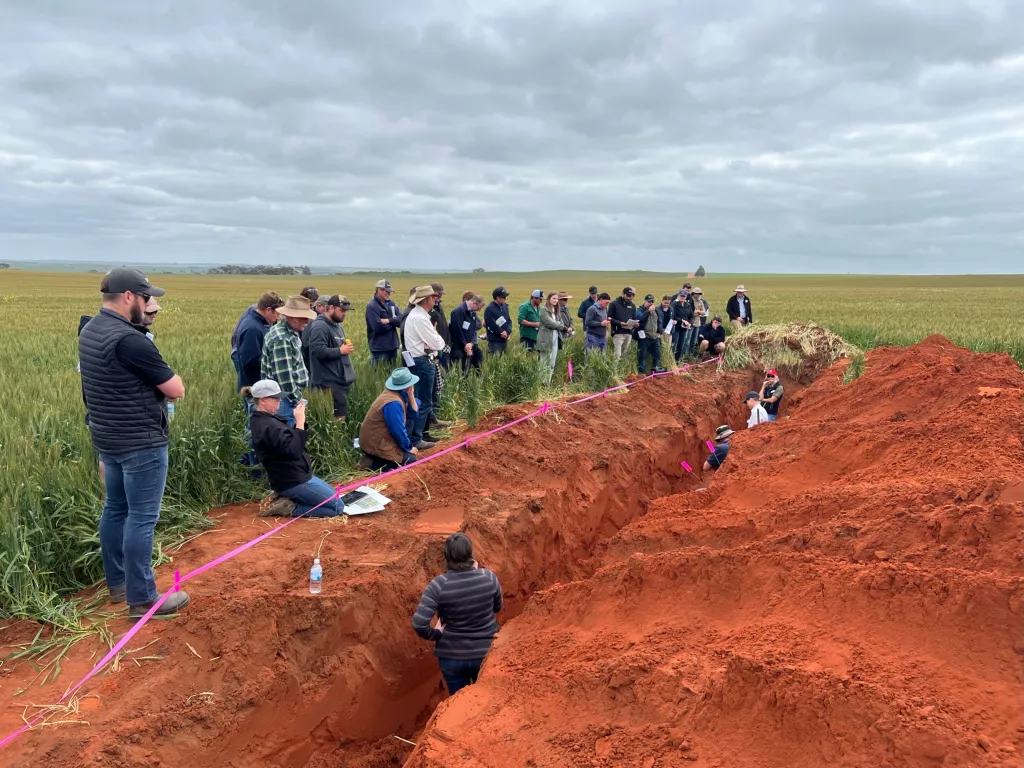Evolving Soil Testing Project Discussion Event - Farmer Summary
Hosted by Brendan Van Beek, Moora

This closed invitation event was an opportunity for participants on the Evolving Soil Testing Project to share experiences of the project, compare soil testing results and ask questions to soil professional Joy Sherlock (Valle Agribusiness & Environmental Solutions), who had completed the soil testing, analysis, and reporting. Although it would have been possible to have one on one meetings between Joy and the individual farmers, multiple farmers that were engaged in the project suggested a small get together to share and examine their individual results and discuss future soil testing and farm management plans.
Initial Discussion – “Balarang East” Paddock


After driving together for a tour of Balarang East, the project participants each introduced their personal areas of focus for the Evolving Soil Testing Project followed by host Brendan Van Beek detailing one of his focus paddocks. Brendan was interested in what could be gained from a good pasture and grazing program on this paddock and how this would be reflected in annual soil testing results.
- Balarang East paddock has highly variable soil types (sandy loams, gravel ridges and clay).
- 2022 Season (500ml annual rainfall) – sown Moby barley, Balancia clover, Arrowleaf clover, Hycon Rose clover, and vetch. This mix was sown at different seeding rates to accommodate the variable soil types within Balarang East.
- 2023 Season (200ml annual rainfall) – Moby Barley from previous season had established (poorly) but was quickly grazed out by sheep. Sown vetch, cubclover and Balancia clover again, but had missed the first rain of the season and struggle to establish these pastures.
- The standout performer of 2022 was the Balancia clover.
- Brendan and Murray Grey discussed the grazing value of vetch, and both believe that it is not grazed until later in the season.
Each farmer discussed different management strategies and seasonal observations, posing questions to each other, Joy and the WMG team in the paddock before heading back to the shed for the in-depth soil testing results discussion.
*Other project topic focus results and discussions can be found in the case studies available on the Evolving Soil Testing Project page.
In-Depth Soil Testing Results Discussion (In the shed)


Joy had put together a complete information pack for each participant, containing soil test results, interpretation guide, in-depth soil report and a series of case studies. These were shared amongst the group for some initial discussion before Joy ran through the interpretation guide on one set of results, followed by an in-depth look at each participants results. Highlighted below is a snapshot of some of the discussion points from the first of these in-depth sessions.
Balarang East Paddock
Soil testing was completed in Balarang East in 2022 and 2023 through different contractors. This brings a level of sampling variation and bias, and differences in soil analysis methodology that Brendan is aware of. It was also recognised this would bring some complexity in the ability to compare results. Brendan had hoped to see an increase in soil carbon and nitrogen from highly productive legumes. Although there was a nitrogen increase, it was not as much as initially expected. There was a suggestion that some nitrogen could be tied up with carbon in the soil and is not reflected in the testing results. Brendan and Will Browne discussed the Cation Exchange Capacity (CEC) results, and the practical ways farmers can influence this. Sandy soils will tend to have a low CEC. Adding clay was discussed as an effective amendment influencing the CEC and increasing soil fertility.
*Further results and discussion of Balarang East can be found in Case Study 1 on the Evolving Soil Testing Project page.
Boxhall Paddock
Brendan wanted to have a better understanding of the long-term effects of spreading pig manure over a continuous cropping paddock. Boxhall paddock isn’t the ‘top’ performing paddock on the farm but is a regularly productive paddock. The soil testing revealed zinc was present in excess, which Brendan suggested could be caused by the zinc used in pig medication. There was a discussion between the group about what a practical change on farm is, especially as farm scale increases. It can be difficult to change the management of a small area of the farm, particularly in scenarios when this change could be considered a ‘1%-er’. There was an imbalance in the ratio between fungi and bacteria populations and the group was unsure in how this could be manipulated. Joy suggested to think about creating an overall healthy soil environment so fungi and bacteria populations could thrive.
*Further results and discussion of Boxhall can be found in Case Study 1 on the Evolving Soil Testing Project page.


Future Plans
Once the group had completed the in-depth results discussion, farmer attendees all shared their future soil testing plans, for 2024 and beyond. All farmers agreed that they had evolved their soil testing practices and understandings but would not soil test and collect data simply for the sake of collecting data but wanted to continue to expand their understanding of their farming environment. Brendan and Will both suggested they were interested in increasing the depth of soil testing. Brendan in particular wanted to test prior to soil amelioration. Murray will continue to tie soil testing and plant tissue testing together in his pursuit to understand the nutrient cycling between soil, plant, and livestock in his farming system and to improve his knowledge of soil biology.

End of Day Quotes
“There has been gold in this session that everyone could learn from.” – Will Browne
“I feel you can ask any question in this environment…everyone is striving for the same thing during these sessions.” – Murray Grey
“It is easy to contribute and be involved in a small group.” – Brendan Van Beek













